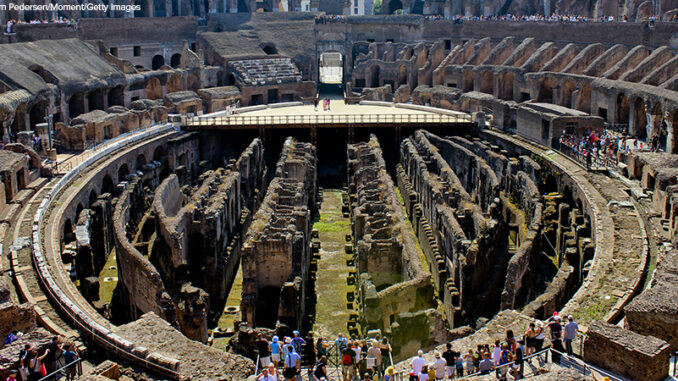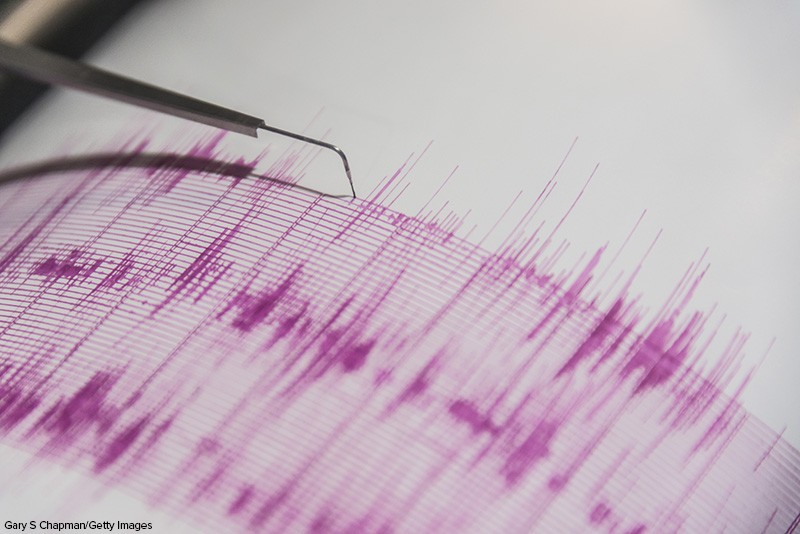
A New Look for the Colosseum
The Colosseum in Rome has been around since the first century. And now, it’s getting an update.
The Colosseum, also known as the Flavian Amphitheatre (because it was built during the Flavian dynasty), is the largest amphitheater in the world. It’s also one of the most famous landmarks anywhere, drawing roughly 8 million tourists per year. In ancient times, the amphitheatre hosted animal hunts, gladiatorial games, and public executions, with audiences of up to over 50,000 spectators. In the 1800s, archaeologists removed its floor to reveal the complex network of tunnels and other structures underneath it, which were used to move animals, people, and props around and up into the arena. But now, the Italian government wants to restore the floor–with a cost of 18.5 million euro ($22.2 million).
The goal of the new 32,300-square-foot floor–funded by Italy’s Ministry of Cultural Heritage and Activities (MiBACT)–is to recreate the original look of the Colosseum, while at the same time preserving it. The floor will be able to open and close just as the original one did, but it will be environmentally sustainable, made of Accoya wood. To protect the delicate structures underneath the floor, a mechanical ventilation system will be installed to control the temperature and humidity. In addition, a water collection system will prevent rainwater buildup and will reroute it to the Colossuem’s public restrooms. Once the new floor is completed, the Colosseum will be used to host concerts and theater productions.
The new floor will be completely removable, allowing flexibility for future generations. The project begins this year, and it’s estimated to be completed by 2023.
Dig Deeper Imagine that you are in charge of the advertising campaign for the newly renovated Colosseum. Create a poster encouraging tourists to visit and experience its new look.
New Earthquake Alert System Could Save Lives on the West Coast
Where in the United States are you most likely to experience an earthquake? The answer is the West Coast, where many fault lines make this the most earthquake-prone region of the country. But the devastating effects of these quakes can be lessened if people are warned early that one is coming. To this end, the Federal Emergency Management Agency (FEMA) has devised a Wireless Emergency Alert System, which is sent via ShakeAlert to warn residents that tremors have been detected. The lead time isn’t a lot right now–only up to ten seconds–but in an emergency situation, even seconds can be critical.

ShakeAlert is the product of fifteen years of planning and development. The rollout began with California in 2019, expanded to Oregon in March 2021, and is now in Washington. This means that more than fifty million people will now have access to this technology. So how does ShakeAlert work? The USGS Advanced National Seismic System’s sensors pick up P-waves, which are the fastest waves to travel from a ruptured fault line. This data is sent through the Wireless Emergency Alert system. A text message blast is then sent out to all users, similar to an Amber Alert. It usually takes about 2.1 seconds for a warning to pop up on someone’s phone. Also, warnings will only be sent out for quakes with a magnitude 5 or higher.
Dig Deeper Use Internet resources to learn more about West Coast earthquakes. What are the major fault lines along the West Coast? What have been some of the most devastating quakes? Write a short paragraph about what you find.
Trump’s Ban from Facebook Upheld
With tens of millions of followers, and dozens of lawsuits, ex-president Donald Trump had quite a complicated relationship with social media. And that didn’t end with his presidency. After the riot at the U.S. Capitol on January 6, 2021, Facebook banned Trump from the platform because they said he had used it to encourage violent action. Trump argued that the social media company had taken away his right to free speech. His supporters have complained that by banning Trump, Facebook has shown that it is biased against conservatives.
Now Facebook’s Oversight Board has reviewed the case. The Board agreed that Trump’s posts supported and encouraged the rioting and violence. But while they agreed that Facebook was right to suspend Trump and that the company doesn’t need to restore his privileges right away, he has not been permanently banned. They want the disciplinary process needs to be clearer and more transparent. According to the Board, Facebook now has six months to make a final decision about whether they want to restore his account, suspend him for a finite timeperiod, or suspend him permanently.
In the meantime, Trump has taken his social media matters into his own hands. Last week, he added a page to his website (called “From the Desk of Donald J. Trump”) that is essentially a blog. Followers can’t comment or reply, but they can share these posts to social media. It’s also possible that Trump–who has been banned from Twitter and Google as well–could seek out one of the newer social platforms, such as Clubhouse or TikTok.
